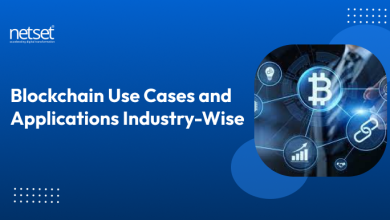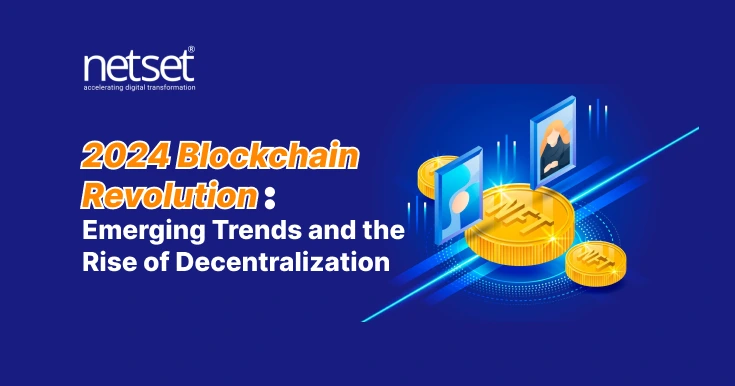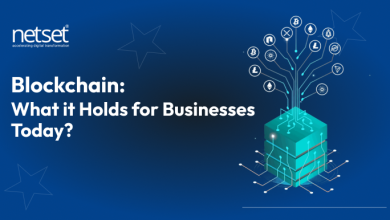How to Build Blockchain-Based Patient Data Management Solutions for Healthcare
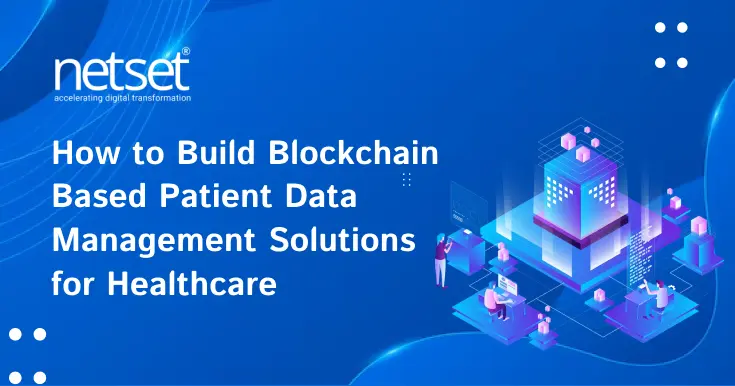
Managing patient data has become more important as well as challenging, pushing the healthcare industry to undergo rapid transformation using technology. Between hospitals, clinics, labs, and insurance providers, the information of patients is stored in multiple places. This as a result leads to data silos, manual errors, and the high risk of security.
But what if there was a way to make this system highly secure, transparent, errorless, and efficient? Well, the answer is blockchain technology.
And, if you are an entrepreneur or a healthcare institution willing to learn more about creating a blockchain-based patient data management system, here is everything you need to know while bringing your solution to life.
Why is blockchain the best solution for patient data?
Before we get into how to actually create the solution, we must talk about why blockchain is such a powerful option when it comes to healthcare data management. Some of the key benefits of blockchain in healthcare are:
- Security: Blockchain has a decentralized nature, which makes it very difficult for hackers to alter or breach the records of institutions and patients.
- Transparency: Every data transaction that takes place gets recorded and is traceable, giving the best of accountability.
- Patient Control: Due to its decentralized nature, patients have more control over who accesses their healthcare records.
- Interoperability: As data is stored on the blockchain, it can easily be shared across different systems, departments, or institutions without any hindrances.
The healthcare systems today are still depending on outdated technology, which leads to gaps that blockchain technology can solve efficiently, giving the most secure way to manage the data of patients.
Step-by-Step Guide for Creating a Patient Data Management System Running on Blockchain
Now, let’s go through the breakdown of what it takes to create your own solution, starting right from the idea to final implementation.
Step 1- Understanding the Use Case Deeply
Before you consult a blockchain software development company to start development of a solution, you have to be very clear about the problem you want to solve.
You can consider asking yourself:
- Is the goal to simplify patient data sharing between departments?
- Am I trying to improve data accuracy and reduce errors?
- Do I want to give patients direct control over their medical records?
These are some of the questions that will help you understand the problem deeply as well as design the system with a clear purpose.
Step 2- Choosing the Right Blockchain Platform
Not all the blockchain platforms are created on the same platform so it is important to pick the best platform that highly aligns with your goals. There are a few popular platforms that are popular in blockchain for healthcare mentioned below:
- Ethereum is great for smart contracts and public solutions.
- Hyperledger Fabric is a permissioned blockchain, which is ideal for enterprise-level usage.
- Polygon or Solana is a fast and cost-effective platform for highly scalable solutions.
It is completely ok if you are not sure about the platform you want to choose. Your blockchain app development partner will guide you through the best platform options for your vision.
Step 3- Design the Data Structure
Know that healthcare data consists of everything from patient history to the prescriptions, lab reports, and billing. And not all of this data must live directly on the blockchain, accessible to everyone.
A good approach is to
- Store the sensitive data off-chain and in encrypted databases.
- Store hashes or pointers to that data on the chain, giving you the best of integrity with traceability.
This will keep your system fast, secure, and scalable as your healthcare solution grows in the future.
Step 4- Integrate Smart Contracts
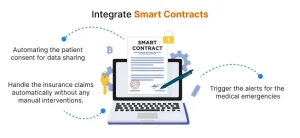 Smart contracts are very important when it comes to blockchain, as they are the self-executing codes that completely automate and secure the actions between multiple parties. For the healthcare sector, they can help in:
Smart contracts are very important when it comes to blockchain, as they are the self-executing codes that completely automate and secure the actions between multiple parties. For the healthcare sector, they can help in:
- Automating the patient consent for data sharing
- Trigger the alerts for the medical emergencies.
- Handle the insurance claims automatically without any manual interventions.
These services play a major role in keeping the healthcare workflows reliable and secure, so when you hire a blockchain smart contract developer, make sure they are a reliable team.
Step 5- Create the User Interface
Even if you create the most advanced and powerful backend system, it won’t be helpful if users are not able to navigate the system. Do design a simple, clean, and minimal interface for the
- Doctors and nurses to view and update the records
- Patients to review and grant the access to their data
- Admin staff to manage the permissions and system settings
Now, when you plan the user interface, keep compliance in mind. The system must comply with regulations like HIPAA (in the US) or GDPR (in Europe) or your local healthcare guidelines for providers.
Step 6- Don’t miss out on data privacy
When it comes to custom blockchain healthcare solution development, this step is very important as it ensures that your solution stays secure as well as legally compliant. Some areas where you must focus are applying the
- End-to-end encryption for the complete off-chain data
- Role-based access controls mentioning who can see or update what elements
- Audit logs to keep track of every action
Step 7- Testing and Deploying the Solution
Once your solution is ready from the development team, it is going to go through the testing phase. In the testing phase it goes through
- Functionality testing: Do all the features work as designed and expected?
- Security Testing: Are there any vulnerabilities in the solution?
- Compliance Testing—Does it meet the healthcare regulations?
As the testing process is finished, your healthcare solution is ready for deployment, which can be either on the cloud-based infrastructure or on the premises servers. It depends on what the healthcare institution prefers. Your blockchain app development company will make this step faster and smoother as they have all the technical and regulatory knowledge.
Step 8- Maintenance and Support for the Long Term
A tech product is not finished after deployment because there are always some new features to introduce, some new problems to solve and some new changes to make as per the users. You will have to:
- Monitor the performance constantly.
- Update the smart contracts whenever needed.
- Keep up with the changes in the healthcare regulations.
- Providing the support for medical staff and patients whenever they need it related to solutions.
This phase is not something you have to look outside for, as your blockchain software development services provider will offer you a long-term support option to keep your solution running smoothly.
Real-World Benefits for Healthcare Institutions
Other than the most popular blockchain benefits, healthcare providers also gain the below results.
- Better patient trust: When patients know their data is secure and under their own control, they are more likely to engage with the specific healthcare provider.
- Less Administrative Burden: Automation of manual processes like insurance claims and patient consent will save a lot of time and money for the administration.
- Faster Diagnosis and Treatment: Real-time access to the complete medical records will surely speed up the final decision-making for healthcare institutions.
- Better Compliance: With built-in audit trails and access control features, the complete operation will meet the compliance standards with minimal effort.
What Entrepreneurs Should Know?
Now that you know the benefits of blockchain, detailed steps in developing the solution and benefits to the institutions, there are a few tips that you must know for a successful product:
- Know your audience because you have to understand the daily struggles of hospitals, clinics, and other providers.
- Build partnerships early, even before you start marketing your product, as healthcare experts can help you design a better and more practical solution.
- Start small and scale fast because targeting diverse use cases may lead to a lot of risks.
- Invest in reliable smart contract development services providers, as it sets the foundation for your healthcare solution.
Final Thoughts
Blockchain is slowly becoming a game changer for the healthcare sector, as with the right strategy, tools, and team, it is possible to build a secure and transparent patient data management system. No matter if you are a healthcare institution planning to modernize your systems or an entrepreneur trying to solve healthcare institution problems, blockchain is your best bet. To get started, all you have to do is partner with a trusted blockchain software development company and release your solution.
